Apple MacBook Pro 13: Can a Mac Be a Decent Windows Laptop?
by Vivek Gowri on October 14, 2010 9:00 PM ESTApple MacBook Pro 13—Surprisingly Powerful 320M
Ah yes, the NVIDIA GeForce 320M, a.k.a. the excuse given for why the MBP13 is still running Core 2. It’s an integrated chip, with 256MB of system memory allocated to the IGP. As I said before, it’s got 48 CUDA cores clocked at 450 MHz, compared to the G 310M (in most of ASUS’ ultraportables) which has 16 CUDA cores at 625 MHz. It’s based on NVIDIA’s GT216 core and is basically an integrated version of the GeForce GT 325M. Interestingly, NVIDIA also has a similarly (and rather confusingly) named GT 320M (found in the HP dv6/7t) but that is a dedicated card with a stripped version of the GT216 core and has 24 pixel pipelines clocked at 500 MHz.
So, there’s your NVIDIA mobile GPU lesson for the day. But here’s the basics—the 320M is the replacement for the old 9400M and is basically a GT 325M integrated into the chipset. We expect it to run squarely in between the ASUS ultraportables and the N83Jv/Alienware M11x (GT 335M), slightly slower than the GT 325M, and somewhere around the ATI HD 5470. Here's how gaming performance stacks up.
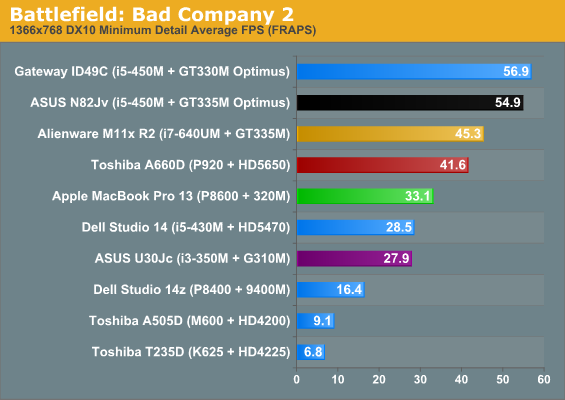
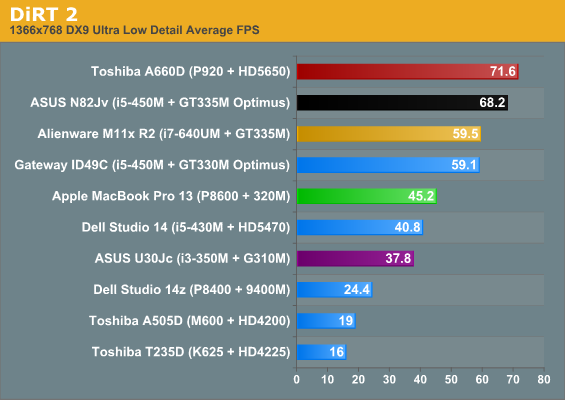
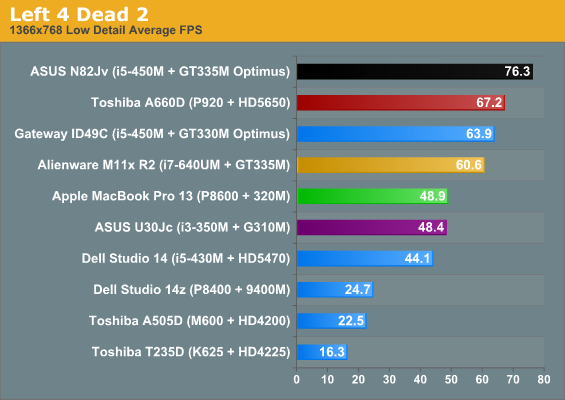
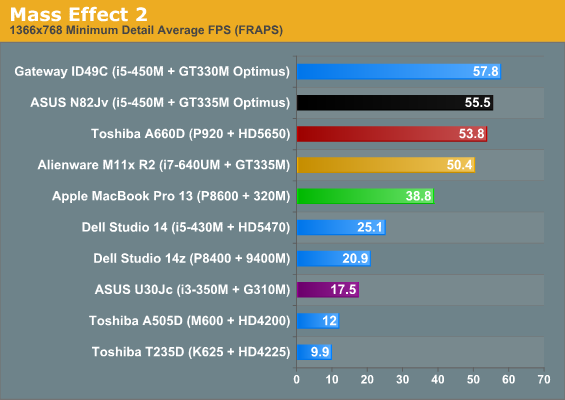
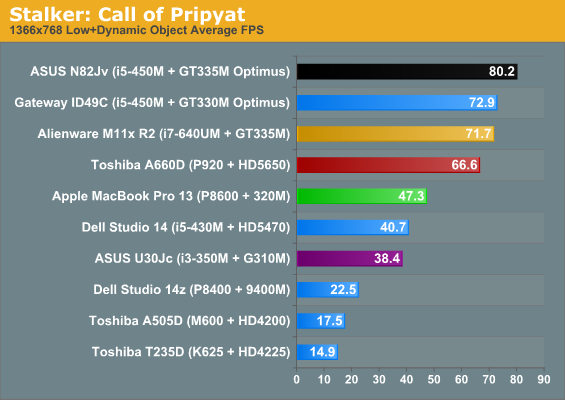
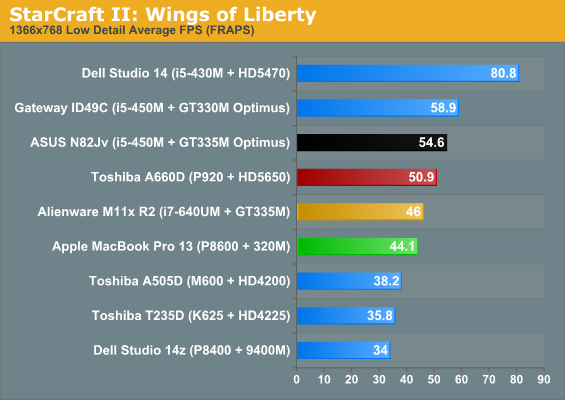
Under low settings, the MBP ended up around 10% faster overall than the Dell Studio 14, which has the HD 5470 (excluding the StarCraft II number). The Alienware M11x, ASUS N82Jv, and Gateway ID49C remain quite a bit faster, as expected, while the ASUS U-series end up significantly slower. The other integrated solutions (9400M, HD 4200/4225) are comparatively woeful. With the G 310M, you can play basically everything in our benchmark suite (except Mass Effect 2) at native res, lowest detail settings. With the other integrated graphics solutions, you need to take the resolution down a few notches to get anything even resembling a playable frame rate.
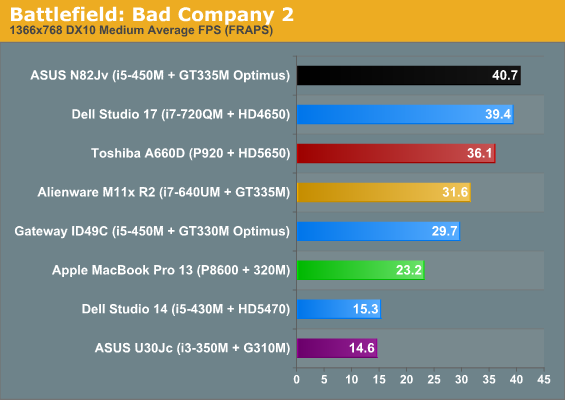

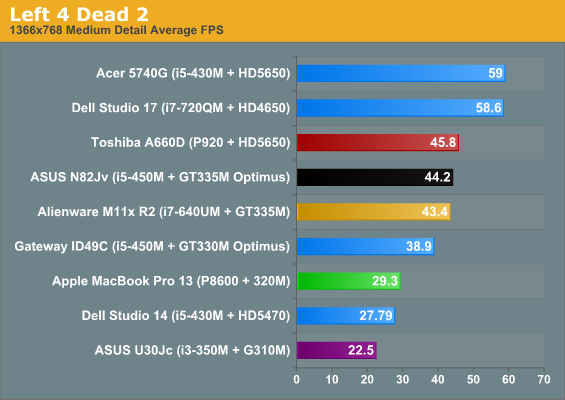
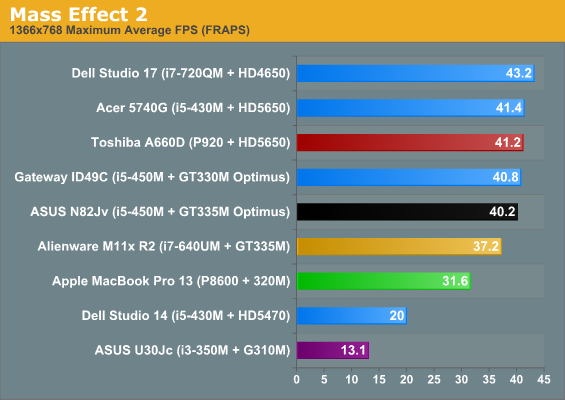
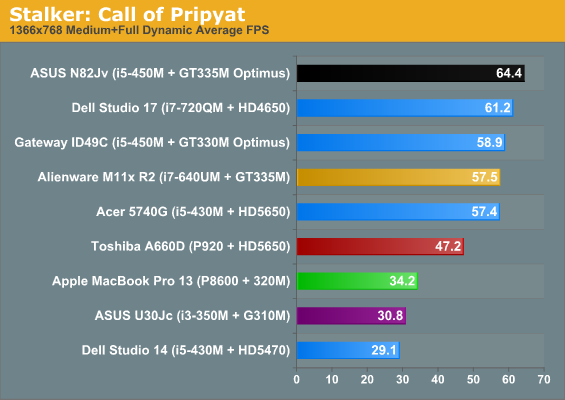
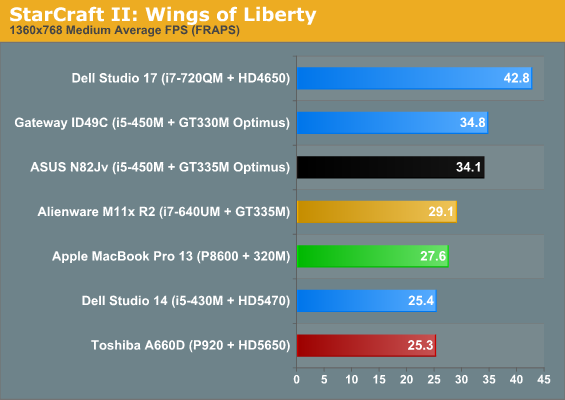
At medium detail settings, I expected the 320M to falter, but it surprised me by staying playable in all of our benchmarks. Bad Company 2 is a bit low, but if you really want to play it at Medium it’s possible, unlike with the G 310M and other low end dedicated graphics units. Frame rates in the mid-20 to low-30 range are awesome by mobile IGP standards. Things that aren’t playable on the G 310M, like Mass Effect 2 and Left 4 Dead 2, hit the magical 30 fps mark with the 320M. The 320M performs more like a midrange mobile GPU than any shape or form of integrated graphics; this is understandable given it’s roots as an integrated GT 325M, but it's still pretty awesome.










117 Comments
View All Comments
yuhong - Friday, October 15, 2010 - link
"(And for those people who still cling to the theory that Apple couldn’t fit a third chip onto the board without reducing the battery size or making the notebook larger, that’s nonsense. If ASUS can manage to fit a Core 2010 processor, the chipset, and a dedicated graphics card into a system with similar dimensions to the MBP13 and a 33% larger battery, then Apple could have too. Simple as that.)"Do a detailed comparison of the insides of the two, please.
aniraf - Friday, October 15, 2010 - link
The one thing I've always been interested in is comparing the graphical benchmarks from OSX and Windows7 on the same machine. I don't know why I've never seen this done, but it would certainly be an interesting way to determine which OS takes better advantage of the hardware.Wolfpup - Friday, October 15, 2010 - link
I pay no attention to Donutmark and never have. I really respect Anandtech's resistance to it, how they used to never even post it, and now still downplay it and tell you things like "this is worthless, but here it is because some people want it".I'm fine with that-if it helps the site, leave the Donutmark stuff in. If not, dump it I guess.
djcameron - Friday, October 15, 2010 - link
I had to buy a unibody 13 inch Macbook for a past job. Once the job was over, I set up a minimal OS X partition for updates, and then made Windows 7 Ultimate my primary partition.It works great, and I don't miss OS X at all.
FYI... The obnoxious Delete(really Backspace) key becomes a true Delete key if you hold down the Fn key.
radium69 - Friday, October 15, 2010 - link
I really can't justify that steep price, it's just plain insane.I'm buying a tax free MSI GX740 for 1400 USD, and thats with a core I5 460m, 4gig ddr3, 500gb 7200RPM HDD, and a RADEON 5870M! It's 17" but I don't mind!
It also comes with a 9 cell battery so should be plenty!
For other stuff where I have NO wallsockets I just use my EEEPC 1000H. Works very well for the basic stuff.
The only + is the screen that looks good. But why is it good if you need to play everything on ultra low / medium settings. Sure the macbook is more portable, but you can get a lot more bang for the buck.
Just my 2 cents,
lorribot - Friday, October 15, 2010 - link
......Apple would release OSX in to the wild.RussianSensation - Saturday, October 16, 2010 - link
"The majority of the expense is in higher quality components and build, but my point is that the 15" i5 MBP is only $300 higher than the 2.6 ghz Core 2 Duo MBP 13" and the i5 is between 50% and 100% faster depending on the task."johnspierce, what are you smoking?
Core i5 is at best 20% faster in performance per clock than a C2D Penryn architecture design. So no, there are 0 tasks where a Core i5 will be 50-100% faster than a C2D at the same clock speed.
And the major reason for a high Mac product pricing is OBVIOUSLY their profit margin. They got all the apple fanatics to believe that their products use "proprietory, specifically selected hardware". Keep in mind EVERY single component inside a MAC other than the motherboard (which everyone who owns a PC knows has 1% impact on performance) is no different than what PCs use. The reason Apple products cost so much $ is because they are:
1) Customer Service (Apple store is amazing!! the customer service is 2nd to none).
2) Image (it's a fashion statement; (the younger generation considers them more hip).
3) Marketing (Apple has outmarketed Microsoft in selling an "easier to use, better, more stable environment").
4) Design - it's impossible for anyone to deny that Apple products are sexy/contemporary and push design trend boundaries.
People pay $$$ for all 4 of these first and foremost when they buy an Apple product, with performance, price/performance ratio being almost irrelevant.
yuhong - Saturday, October 16, 2010 - link
"They got all the apple fanatics to believe that their products use "proprietory, specifically selected hardware"."Which used to be true back in the PowerPC age.
AnnonymousCoward - Saturday, October 16, 2010 - link
"it’s the best chiclet keyboard out there" - great, but how does it compare to a regular laptop keyboard?Klimax - Saturday, October 16, 2010 - link
I have only onel problem with review. The baterry test. Respectively what where the settings? There are few plans available like balanced and minimal power. Which one was chosen?Where they altered?For example,when I alter power level of WiFi I can easkly gain or lose about 50% of battery life and there are more of such options.(like USB suspend ; Link state power mng and min/max processor state along with cooling policy) They all can alter experience and it would be interesting to know how much they can change outcome.